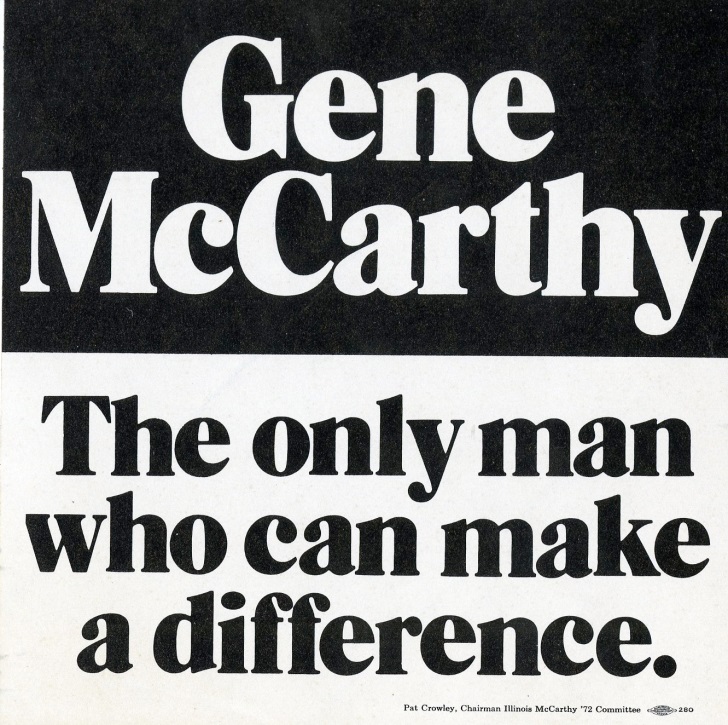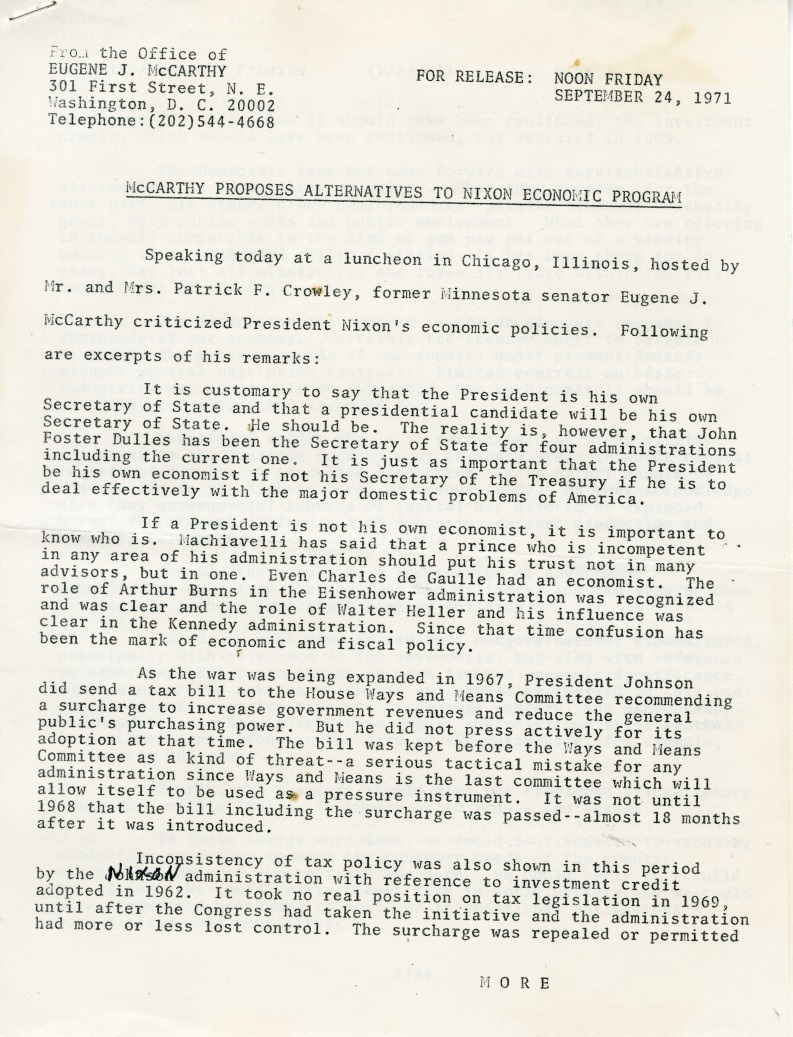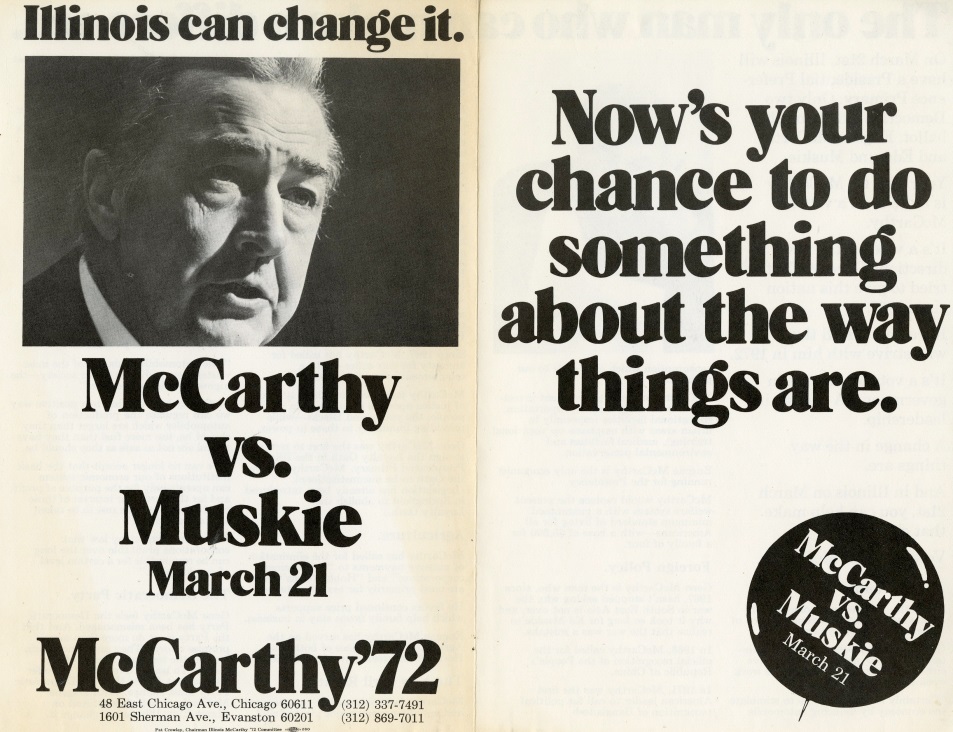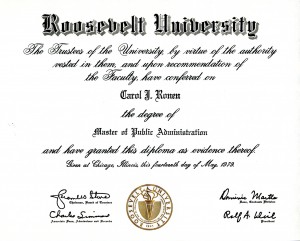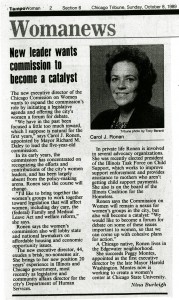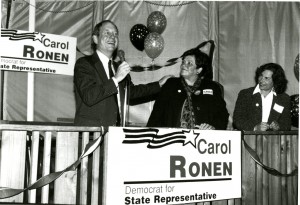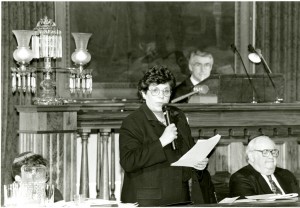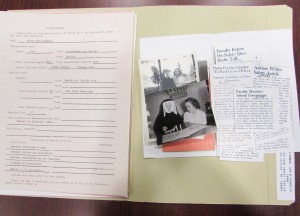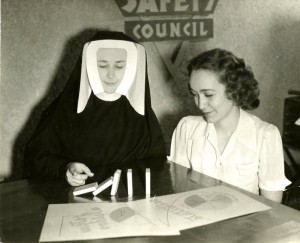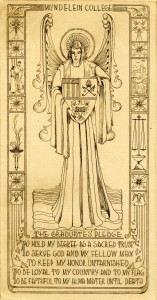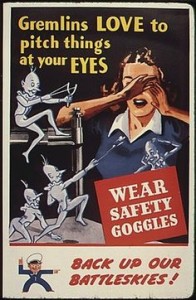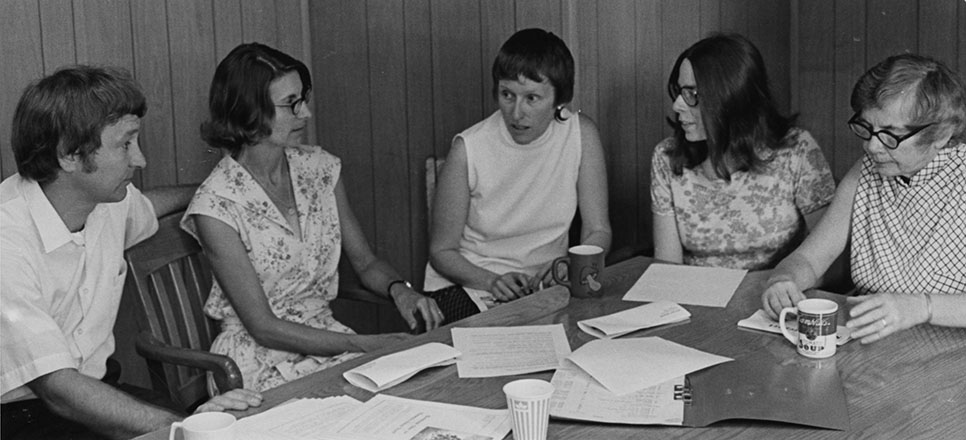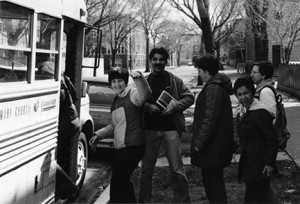Dr. Irene Meyer was a Mundelein College* professor from 1957 to 1992. In that time, Dr. Meyer earned her PhD, became a fervent civil rights activist, and fought for the abolition of capital punishment in Illinois. I first came across Dr. Irene Meyer earlier this year for a reference request. In her file, there were several articles, which marked her involvement with a man on death row. Reading these sparked my curiosity, and I had to see what else we had in our collections on Dr. Meyer. What I learned was that Dr. Meyer has led an amazing life, built an incredible career, and her story is one that needs to be told. Continue reading
Tag Archives: Chicago
Coming Soon To The WLA
When a collection comes into the WLA, a staff member looks at all of the records and comes up with a processing plan to organize the collection and make it accessible for users. Depending on the amount of material, type of material, and how much the donor originally organized it, some collections can be processed quickly and others take months. The goal of processing is to make all of the material easy to find for the user.
Here are some of the collections you can expect to see at the WLA soon! Continue reading
On The Campaign Trail
With the weekly primaries and Super Tuesday right around the corner, I have the 2016 Presidential Campaign on the brain. As advertisements play on TV and friends on Facebook voice their opinions, I am reminded of Patricia Caron Crowley and her family’s work campaigning for Eugene McCarthy during his bid for President in 1968 and 1972. Her collection illustrates the strong involvement of a woman in campaigning for a Presidential candidate. Crowley hosted parties and luncheons with her husband and kept a significant amount of newspaper articles and memorabilia from the campaign trail. Patricia and her husband Pat were ideal candidates to run McCarthy’s Illinois campaign because of their previous experience organizing and raising funds for various organizations. The Crowley’s also had connections with Chicago politicians. While McCarthy never made it to the White House, Patricia’s collection at the Women and Leadership Archives highlights the hard work and effort that goes into campaigning and politics.
Campaigns can be very visual from the TV advertisements, newspaper articles, and yard signs to how a candidate holds himself/herself or what he/she is wearing during a debate. Below are some of the images and visual materials used in the McCarthy Campaign. As you view the images, think about how political advertising has changed and how it has stayed the same. The Crowley’s were a well-connected and well known family in Chicago. How is their support similar or dissimilar from celebrity endorsements today? There are many things that have not changed in the 44 years since the 1972 election but those things that have changed are important for understanding current political thought and the priorities of the American public.

Patricia kept several newspaper articles in a guestbook that contained signatures from luncheon and party attendees

A personal favorite from the Patricia Caron Crowley collection at the WLA is this white and blue campaign hat for McCarthy. The hat includes the word “PEACE” as McCarthy was referred to as the peace candidate in reference to his thoughts on the Vietnam War.
Megan is a Graduate Assistant at the WLA and is in the first year of her M.A in Public History at Loyola University Chicago. She is an avid movie-goer and enjoys arts Megan is a Graduate Assistant at the WLA and is in the second year of her M.A in Public History at Loyola University Chicago. She is an avid movie-goer and enjoys arts and crafts, live sporting events, and small Midwestern towns.
Loyola University Chicago’s Women and Leadership Archives Blog is designed to provide a positive environment for the Loyola community to discuss important issues and ideas. Differences of opinion are encouraged. We invite comments in response to posts and ask that you write in a civil and respectful manner. All comments will be screened for tone and content and must include the first and last name of the author and a valid email address. The appearance of comments on the blog does not imply the University’s endorsement or acceptance of views expressed.
Valentine’s Blast from the Past
In honor of Valentine’s Day, I went in search of something from Mundelein College.* I found this ad in the Skyscraper, the College’s weekly student-produced newspaper.
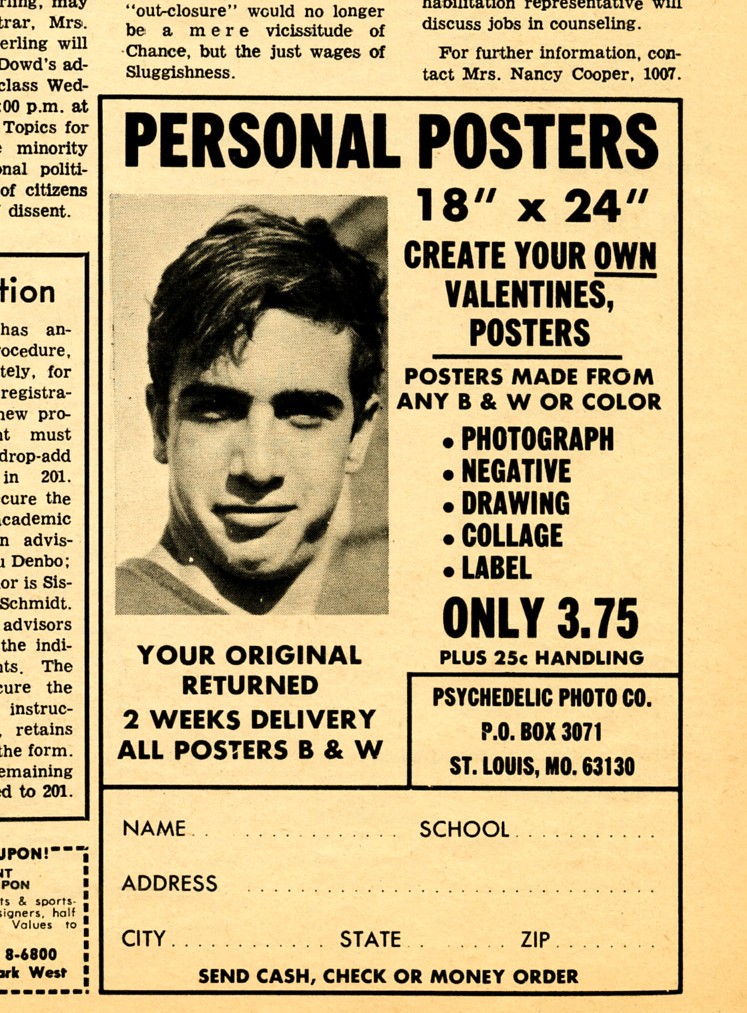
Newspaper ads are a fascinating window in time and this one from January 26, 1968, is no exception. Note the name of the company, Psychedelic Photo Company. The word psychedelic came into being in 1956 from the Greek psyche- “mind” + deloun- “make visible” from delos “visible, clear,” + dyeu- “to shine.” Popular use began in 1965 referencing anything producing effects similar to using a psychedelic drug or enhancing the effects of said drug.
Over the years, I’ve heard the term psychedelic innumerable times, however, this may be the first time as the name of a business. I Googled the company out of curiosity to see if it still existed and alas, no.
Notice the details of the ad. What a bargain price for a black and white or color poster. (How I wish current shipping prices cost 25 cents.) If you hurried after January 26th, when the ad came out in the Skyscraper, you could get a poster in two weeks, in time to give to your Valentine!
*Mundelein College, founded and operated by the Sisters of Charity of the Blessed Virgin Mary (BVM), provided education to women from 1930 until 1991, when it affiliated with Loyola University Chicago. The Women and Leadership Archives (WLA) at Loyola holds the records of Mundelein College.
Nancy became Director of the WLA in spring, 2013. Prior to that, Nancy was an archivist and records manager at a wildlife research facility for the USDA in Colorado. Nancy has worked in the archival field since 1999. When not at the WLA, Nancy enjoys spending time with her family and knitting.
Loyola University Chicago’s Women and Leadership Archives Blog is designed to provide a positive environment for the Loyola community to discuss important issues and ideas. Differences of opinion are encouraged. We invite comments in response to posts and ask that you write in a civil and respectful manner. All comments will be screened for tone and content and must include the first and last name of the author and a valid email address. The appearance of comments on the blog does not imply the University’s endorsement or acceptance of views expressed.
Collections Highlight: Carol Ronen
Born in Chicago on March 28, 1945, Carol Ronen has devoted much of her life to public service in Illinois. In 1967 Ronen graduated from Bradley University in Peoria, IL with a Bachelors of Arts in Political Science and went on to earn her Master’s in Public Administration at Roosevelt University in 1979.
Throughout her career, Ronen was highly recognized as a progressive public servant who advocated the causes of women, early childhood education, health care, violence prevention, and human rights.
In Chicago, Ronen served as the Director of Research and Evaluation for the Chicago-Cook County Criminal Justice Commission as well as Director of Legislative and Community Affairs for the Chicago Department of Human Services. In 1989, she became the Executive Director of the Chicago Commission on Women where she created and facilitated programs that advocated for issues such as domestic abuse and welfare reform.
Carol Ronen served seven years in the Illinois State House of Representatives for the 17th District from 1993-2000. In 2000 she was appointed to the Illinois State Senate for District 7 after the resignation of her predecessor, Arthur Berman.
In the Illinois legislature, Ronen was a major advocate for LGBTQ rights. Ronen was a strong opponent of S.B. 1773, which sought to only recognize heterosexual marriage in the state, when it was proposed in 1996. Additionally, she was the lead sponsor of the Illinois Human Rights Act (2005), which protects Illinois residents from discrimination based on sexual orientation or gender identity. Passing this bill took over a decade of work and, according to Ronen herself, “fulfills a personal commitment I made when I first ran for office – to extend equal protection to Illinois gay, lesbian and trans-gendered citizens.” At the time this Act was passed, there were only four other states that had adopted such sweeping protections.
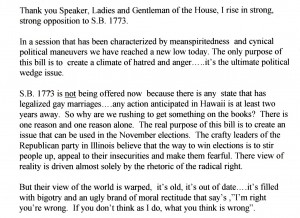
Part of a speech given by Carol Ronen in opposition to S.B. 1773, which would have allowed only heterosexual marriage to be recognized in IL.
Ronen was also a strong supporter of the Equal Pay Act, which increased the number of women covered by equal pay protections, and was a driving force behind increasing the Illinois minimum wage.
In October 2007, she announced that she would be resigning as District 7 State Senator and would not complete her term. She officially stepped down on February 10, 2008, and was succeeded in office by Heather Stearns.
The Carol Ronen Papers at the Women and Leadership Archives consist of 2 linear feet of materials and document the years 1952-2009. Additional papers at the WLA of women involved in politics include the Carolyn Farrell Papers, the Sheli Lulkin Papers, the Mary Ann Smith Papers, the Marion Volini Papers, and the Carol Mosley Braun Papers (currently unavailable for research).
Original research for this post was done by WLA intern Sebastian during the Fall of 2012.
Loyola University Chicago’s Women and Leadership Archives Blog is designed to provide a positive environment for the Loyola community to discuss important issues and ideas. Differences of opinion are encouraged. We invite comments in response to posts and ask that you write in a civil and respectful manner. All comments will be screened for tone and content and must include the first and last name of the author and a valid email address. The appearance of comments on the blog does not imply the University’s endorsement or acceptance of views expressed.
Sister Safety
Image
As part of our Women’s History Month activities, I worked on creating a display showcasing materials from the collection of Mundelein College, a Catholic women’s college that was once located next to Loyola. The exhibit focused on two of Mundelein’s art professors and two students who went on to have successful art careers. This was another great opportunity to find new things and learn more about life at this unique college for women.
As I researched the art professors of Mundelein, I found interesting details on the life of Sister Mary Carmelyn. Sister Mary Carmelyn McMahon was born in Missoula, Montana in 1905 and taught at Mundelein from 1934 to 1954. Sister Mary Carmelyn designed several of the college’s Christmas cards and even illustrated the Graduate Pledge, which was taken by seniors at every commencement ceremony.
While inspiring students in her role as a teacher, Sister Mary Carmelyn discovered something else about which she was passionate. She began the College Safety Council at Mundelein in 1943 and spent her time learning and sharing ways to prevent accidents on school campuses and beyond. In the 1940s, she dedicated much of her time to the Red Cross and was appointed to serve on many safety councils, including the Education Committee of President Truman’s Conference on Highway Safety. She even taught the other BVM’s to swim. I wish we had a photo of that to share!
This sudden concern for accident prevention seems out of the blue, but Sister Mary Carmelyn was actually just doing her patriotic duty. In the midst of World War II, factories increased production to provide supplies. Meanwhile, workplace accidents and injuries also increased. The National Safety Council, with the support of President Roosevelt, launched a national campaign in 1941 to teach ways to avoid accidents in industries, homes, schools, and on the road. Citizens could support the war effort by preventing carelessness that would waste resources or result in injury to much needed workers.
Sister Mary Carmelyn participated in the movement that spread these safety lessons to all areas of life. She promoted the 3 E’s of accident prevention: Education, Engineering, and Enforcement. She also wrote an article for Safety Education Magazine explaining the forgotten “R” in safety, religion. “Knowledge of skills,” Mary Carmelyn wrote, “plus the realization and acceptance of man’s relationship to his fellow men and his Creator, will…direct the knowledge toward…attitudes of safe living.”
Exploring Sister Mary Carmelyn’s records in the Mundelein College Collection provided the opportunity for me to learn more about national events during World War II. Through the archives, I was able to see one fascinating woman’s participation in broader patterns of history.
Caroline is a Graduate Assistant at the WLA and is working on her Master’s in Public History at Loyola University Chicago. She spends her spare time caring for her pufferfish, interpreting dreams, and watching cheesy movies.
Loyola University Chicago’s Women and Leadership Archives Blog is designed to provide a positive environment for the Loyola community to discuss important issues and ideas. Differences of opinion are encouraged. We invite comments in response to posts and ask that you write in a civil and respectful manner. All comments will be screened for tone and content and must include the first and last name of the author and a valid email address. The appearance of comments on the blog does not imply the University’s endorsement or acceptance of views expressed.
Collections Highlight: 8th Day Center for Social Justice
Founded in 1974 by six Catholic organizations located in Chicago Illinois, the organization the 8th Day Center for Justice is an inter-faith coalition that strives to do social justice work that impacts Chicago and the surrounding communities.
For nearly 40 years the organization has made a difference in the lives of hundreds of Chicagoans, many of them women. In their efforts to help women, they have broadly invested in issues such as education, war, universal human rights, poverty, and homelessness. Drawing from firm and long-held religious beliefs, the organization’s activism is peaceful and concentrates on consciousness raising, community organizing, workshops, and lobbying.
The Urban Plunge, one of the organizations longest running programs has occurred annually since 1977. This Easter Week event is a weeklong faith-based immersion program in which participants engage with the city of Chicago through exploring its spaces and meeting local community and religious leaders and organizations actively making an impact. Formulated to encourage participants to analyze their surroundings and utilize their talents, the tour creates a space for participants to brainstorm solutions for the problems and challenges facing contemporary society.
In 1981, 8th Day Center began an annual event called the Good Friday Walk for Justice, to draw attention to contemporary social justice issues concerning racial, economic, and legal inequalities. Themes of the walk are different every year and generally have a historic or religious significance. The event leads participants to five different locations positioned to create a cross in downtown Chicago. Led by a coalition of social justice and faith organizations with prayer and reflection built into the script, the event encourages individuals to act and provide voice for those who are unable to speak.
From their general events such as the Urban Plunge and Good Friday Walk for Justice to participation in national movements such as the Sanctuary Movement and advocating for the Equal Rights Amendment, 8th Day contributed to debates not just on local issues and topic, but national and international ones as well. The organization has specifically explored the conditions of women in Asia. Within the United States, they have commented on issues of discrimination, employment, violence, and women’s ordination.
Laura is a 2014 graduate of the MA in Public History Program at Loyola University Chicago and a former WLA Graduate Assistant.
Loyola University Chicago’s Women and Leadership Archives Blog is designed to provide a positive environment for the Loyola community to discuss important issues and ideas. Differences of opinion are encouraged. We invite comments in response to posts and ask that you write in a civil and respectful manner. All comments will be screened for tone and content and must include the first and last name of the author and a valid email address. The appearance of comments on the blog does not imply the University’s endorsement or acceptance of views expressed.
A Story in a Box
My main task the last few weeks has been preparing for Women’s History Month in March. Women’s History Month is an opportunity to celebrate some of the unique women in our collections through weekly posts on our website. My first step in writing these posts was to peruse our finding aids and find four collections I wanted to share. Among the many fascinating individuals and organizations, one woman’s story stood out to me and begged to be shared. Her collection consisted of only one small box, but in that box I found many cool things that represented a life of leadership and spirit.
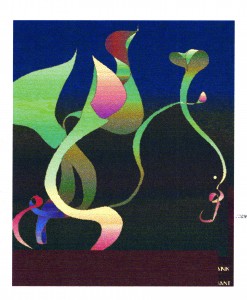
While Anna’s early artwork included watercolors and sculpture, she made her later work on the computer as her condition increasingly affected her coordination.
Anna Stonum’s finding aid described her as an activist and artist, two categories the WLA has many of, but this woman’s story was different. She is a great example of the diversity of our collections.
Anna Stonum, born October 14, 1958, moved to Chicago in 1980 to attend Mundelein College. Anna suffered from Friedrich’s Ataxia, a degenerative condition that affects coordination and caused her to spend most of her adult life in a wheelchair. Anna was a passionate artist who worked with different media as her coordination worsened, but never quit creating. In the 1980s, she joined the movement fighting for rights for the disabled and demonstrated her leadership and courage. She picked fights with the CTA, Wrigley Field, and Jerry Lewis, all in the name of accessibility and respect for those with disabilities.
Anna’s papers don’t contain any photos of her, other than a couple tiny, grainy images from news articles. I was concerned that I wouldn’t have a picture to accompany her web feature, and then I found this.
Pretty cool, huh? OK, maybe it seems a little dramatic at first, but Anna and her husband Mike Ervin were cool enough to pull it off. And don’t you kind of want someone to paint you looking like you’re ready to conquer the world in the middle of a lightning storm?
The portrait was done by artist Riva Lehrer for her series Circle Stories. Before creating this portrait, Lehrer interviewed her subjects to learn about their lives and find imagery that represented their experience. This powerful image illustrates Anna and Mike’s determination and strength as a team.
So why does this couple deserve such an intense tribute?
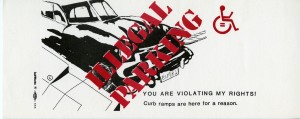
Designs for All created this sticker for the disabled to remind drivers why handicap parking spots existed.
As a woman who just recently moved to the big city, I am fascinated by Chicago’s public transportation and have been amazed by the technology that allows buses to lower and lift wheelchairs so that everyone can take advantage of these vehicles. Today, every CTA bus you ride is accessible because of Anna, who helped found the Chicago chapter of Americans Disabled for Accessible Public Transit. The organization spent years fighting for CTA to install lifts before the company committed to ordering 700 accessible buses in 1989, influencing similar cases across the nation.
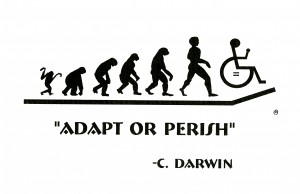
Designs for All created this sticker for the disabled to remind drivers why handicap parking spots existed.
Anna’s strength and spirit can also be seen in her refusal to let challenges get in the way of her creativity. In 1994, Anna started her own graphic design company, Designs for All. She mostly did work for newsletters, but she also created some cool logos and designs that were used nationally by disability activists.
Anna Stonum passed away suddenly at the age of 40 due to a heart attack. As sad as this was to learn, it was from the writings of her friends and family after her death that I learned the most about who Anna was as a person. Her collection contains her obituary, where a friend describes how she inspired others who saw how much she enjoyed living. There is also a copy of New Mobility magazine that includes an article her husband wrote after her death. He tells stories about how he spontaneously proposed after a couple of cocktails in New Orleans and about one of the many times they were arrested for “raising hell with ADAPT” and spent three days in a Canadian jail.
When you jump into a collection, you never know what you might find. Sometimes, it’s hard to understand a person through documents and articles. But with Anna Stonum, her passion and strength could be found in every folder.
Caroline is a Graduate Assistant at the WLA and is working on her Master’s in Public History at Loyola University Chicago. She spends her spare time caring for her pufferfish, interpreting dreams, and watching cheesy movies.
Loyola University Chicago’s Women and Leadership Archives Blog is designed to provide a positive environment for the Loyola community to discuss important issues and ideas. Differences of opinion are encouraged. We invite comments in response to posts and ask that you write in a civil and respectful manner. All comments will be screened for tone and content and must include the first and last name of the author and a valid email address. The appearance of comments on the blog does not imply the University’s endorsement or acceptance of views expressed.

